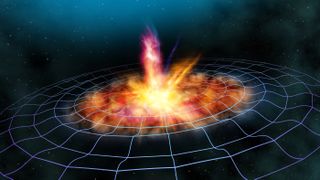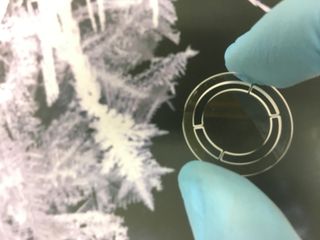
Two intriguing signals spotted in a small gravitational-wave detector could represent all kinds of exotic phenomena — from new physics to dark matter interacting with black holes to vibrations from near the beginning of the universe. But, because of the experiment's novelty, researchers are being cautious about claiming a discovery of any kind.
Facilities such as the Laser Interferometer Gravitational-Wave Observatory (LIGO) use gigantic laser-driven detectors to look for enormous ripples in the fabric of space-time known as gravitational waves. These come from the collisions of black holes and neutron stars out in the distant universe, which are events so powerful they shake space-time and send out surges with wavelengths measured in hundreds of miles.
Related: 8 ways we know that black holes really do exist
Long before these huge observatories were built, scientists suspected that gravitational waves of such sizes existed, because they knew that black holes and neutron stars should sometimes crash together, Michael Tobar, a physicist at the University of Western Australia in Perth, told Live Science.
But there aren't any well-understood sources for gravitational waves with shorter wavelengths of between a few feet and a few miles, he added. Nevertheless, "in the universe, there's always things that we don't expect," Tobar said.
Recent years have seen a push to build detectors that can search for these smaller gravitational waves, including one built by Tobar and his colleagues. Their device consists of a disk made from crystal quartz 1 inch (3 centimeters) in diameter, with a resonant chamber that produces an electrical signal whenever it vibrates at certain frequencies.

Tobar likened the setup to a bell or a gong that rings at a particular pitch. "If a gravitational wave hit that, it would excite it," he said. The ringing in the crystal is then picked up as an electromagnetic signal by electrical sensors.
Sign up for the Live Science daily newsletter now
Get the world’s most fascinating discoveries delivered straight to your inbox.
The researchers placed their detector behind multiple radiation shields to protect it from background electromagnetic fields and cooled it to extremely low temperatures to minimize thermal vibrations in the apparatus.
During the experiment's 153-day run, the crystal rang twice, each time for one or two seconds. The team's findings appeared Aug. 12 in the journal Physical Review Letters.
Scientists are now trying to work out what caused these results. Charged particles called cosmic rays streaming in from space are one possible explanation, Tobar said. A previously-unknown type of thermal fluctuation in the crystal, which should have been minimal due to the super-cold temperatures, could be another, he added.
But there are also a host of exotic prospects, such as a type of dark matter known as an axion spinning around a black hole and giving off gravitational waves, the researchers wrote in their paper. Many explanations could require previously-unknown physics beyond the Standard Model that describes almost all the subatomic particles and forces in the universe, Tobar said.
Shortly after the Big Bang, cosmologists think the universe went through a period called inflation, during which it expanded exponentially in size, Francesco Muia, a theoretical physicist at the University of Cambridge in the U.K., who was not involved in the work, told Live Science.
At the end of this era, the universe might have gone through a phase transition, sort of like water changing from a liquid to a gas state when it boils, he said. If this happened, the transition might have deposited large amounts of energy into the fabric of space-time, generating gravitational waves that could be seen by this experiment, Muia said.
He doesn't think there is enough evidence yet to say what the events in the crystal were one way or another, but he is excited for this experiment and others like it coming online in the near future.
Tobar agreed. "It would be nice if they were gravitational waves, but who knows," he said.
Now that the researchers have these detections under their belt, they can build more sensors like this one, he added. If several devices see the same signal at the same time, it could potentially point to something out in the universe and help to rule out internal processes like thermal fluctuations inside the crystal.
Originally published on Live Science.

Adam Mann is a freelance journalist with over a decade of experience, specializing in astronomy and physics stories. He has a bachelor's degree in astrophysics from UC Berkeley. His work has appeared in the New Yorker, New York Times, National Geographic, Wall Street Journal, Wired, Nature, Science, and many other places. He lives in Oakland, California, where he enjoys riding his bike.
